An Acromegaly Disease Zebrafish Model Reveals Decline in Body Stem Cell Number along with Signs of Premature Aging
Abstract
1. Introduction
2. Results
2.1. The Acromegaly Model Declines Body Stem Cell Numbers in Various Organs
2.2. The Acromegaly Model Zebrafish Showing Aging Signs
2.3. The Acromegaly Model Elevates Oxidative Stress in Various Organs, Including Body Stem Cells
3. Discussion
4. Conclusions
5. Methods
5.1. RNA-Seq and Data Analysis
5.1.1. RNA Isolation and Library Construction
5.1.2. Mapping and Differential Gene Expression Calling
5.2. Data Analysis
5.3. Gene Set Enrichment Analysis (GSEA)
5.4. Western Blot Analysis
5.4.1. Body Stem Cell Isolation by FACS
5.4.2. SA-b-gal Assay and Quantitation
5.5. Statistical Analysis
Supplementary Materials
Author Contributions
Funding
Data Availability
Conflicts of Interest
References
- Kuwahara, S.; Sari, D.K.; Tsukamoto, Y.; Tanaka, S.; Sasaki, F. Age-related changes in growth hormone (GH)-releasing hormone and somatostatin neurons in the hypothalamus and in GH cells in the anterior pituitary of female mice. Brain Res. 2004, 1025, 113–122. [Google Scholar] [CrossRef] [PubMed]
- Frutos, M.G.S.; Cacicedo, L.; Méndez, C.F.; Vicent, D.; Gonzalez-Muñoz, M.; Sánchez-Franco, F. Pituitary Alterations Involved in the Decline of Growth Hormone Gene Expression in the Pituitary of Aging Rats. J. Gerontol. Ser. A Boil. Sci. Med. Sci. 2007, 62, 585–597. [Google Scholar] [CrossRef] [PubMed]
- Rudman, D.; Feller, A.G.; Nagraj, H.S.; Gergans, G.A.; Lalitha, P.Y.; Goldberg, A.F.; Schlenker, R.A.; Cohn, L.; Rudman, I.W.; Mattson, D.E. Effects of Human Growth Hormone in Men over 60 Years Old. N. Engl. J. Med. 1990, 323, 1–6. [Google Scholar] [CrossRef]
- Coschigano, K.T.; Holland, A.N.; Riders, M.E.; List, E.O.; Flyvbjerg, A.; Kopchick, J.J. Deletion, But Not Antagonism, of the Mouse Growth Hormone Receptor Results in Severely Decreased Body Weights, Insulin, and Insulin-Like Growth Factor I Levels and Increased Life Span. Endocrinology 2003, 144, 3799–3810. [Google Scholar] [CrossRef] [PubMed]
- Guevara-Aguirre, J.; Balasubramanian, P.; Wei, M.; Madia, F.; Cheng, C.-W.; Hwang, D.; Martin-Montalvo, A.; Saavedra, J.; Ingles, S.; De Cabo, R.; et al. Growth Hormone Receptor Deficiency Is Associated with a Major Reduction in Pro-Aging Signaling, Cancer, and Diabetes in Humans. Sci. Transl. Med. 2011, 3, 70ra13. [Google Scholar] [CrossRef] [PubMed]
- Hatipoglu, E.; Yürüyen, M.; Keskin, E.; Yavuzer, H.; Niyazoglu, M.; Döventaş, A.; Erdinçler, D.S.; Beger, T.; Kadioglu, P.; Gündoğdu, S.; et al. Acromegaly and aging: A comparative cross-sectional study. Growth Horm. IGF Res. 2015, 25, 47–52. [Google Scholar] [CrossRef]
- Kong, Y.; Trabucco, S.E.; Zhang, H. Oxidative Stress, Mitochondrial Dysfunction and the Mitochondria Theory of Aging. Interdiscip. Top. Gerontol. 2014, 39, 86–107. [Google Scholar]
- Go, Y.-M.; Jones, D.P. Redox theory of aging: Implications for health and disease. Clin. Sci. 2017, 131, 1669–1688. [Google Scholar] [CrossRef]
- Beckman, K.B.; Ames, B.N. The free radical theory of aging matures. Physiol. Rev. 1998, 78, 547–581. [Google Scholar] [CrossRef]
- Bernet, J.D.; Doles, J.D.; Hall, J.K.; Tanaka, K.K.; Carter, T.A.; Olwin, B.B. p38 MAPK signaling underlies a cell-autonomous loss of stem cell self-renewal in skeletal muscle of aged mice. Nat. Med. 2014, 20, 265–271. [Google Scholar] [CrossRef]
- Wang, Y.; Kellner, J.; Liu, L.; Zhou, D. Inhibition of p38 Mitogen-Activated Protein Kinase Promotes Ex Vivo Hematopoietic Stem Cell Expansion. Stem Cells Dev. 2011, 20, 1143–1152. [Google Scholar] [CrossRef] [PubMed]
- Kim, J.; Wong, P.K. Loss of ATM Impairs Proliferation of Neural Stem Cells Through Oxidative Stress-Mediated p38 MAPK Signaling. Stem Cells 2009, 27, 1987–1998. [Google Scholar] [CrossRef] [PubMed]
- Colao, A.; Grasso, L.F.S.; Giustina, A.; Melmed, S.; Chanson, P.; Pereira, A.M.; Pivonello, R. Acromegaly. Nat. Rev. Dis. Prim. 2019, 5, 20. [Google Scholar] [CrossRef] [PubMed]
- Chanson, P.; Salenave, S. Acromegaly. Orphanet J. Rare Dis. 2008, 3, 17. [Google Scholar] [CrossRef]
- ElBialy, A.; Asakawa, S.; Watabe, S.; Kinoshita, S. A Zebrafish Acromegaly Model Elevates DNA Damage and Impairs DNA Repair Pathways. Boiology 2018, 7, 47. [Google Scholar] [CrossRef]
- Ito, K.; Hirao, A.; Arai, F.; Takubo, K.; Matsuoka, S.; Miyamoto, K.; Ohmura, M.; Naka, K.; Hosokawa, K.; Ikeda, Y.; et al. Reactive oxygen species act through p38 MAPK to limit the lifespan of hematopoietic stem cells. Nat. Med. 2006, 12, 446–451. [Google Scholar] [CrossRef]
- Kobayashi, I.; Moritomo, T.; Ototake, M.; Nakanishi, T. Isolation of side population cells from ginbuna carp (Carassius auratus langsdorfii) kidney hematopoietic tissues. Dev. Comp. Immunol. 2007, 31, 696–707. [Google Scholar] [CrossRef]
- Kobayashi, I.; Saito, K.; Moritomo, T.; Araki, K.; Takizawa, F.; Nakanishi, T. Characterization and localization of side population (SP) cells in zebrafish kidney hematopoietic tissue. Blood 2008, 111, 1131–1137. [Google Scholar] [CrossRef]
- Fatima, S.; Zhou, S.; Sorrentino, B. Abcg2 expression marks tissue-specific stem cells in multiple organs in a mouse progeny tracking model. Stem Cells 2012, 30, 210–221. [Google Scholar] [CrossRef]
- Hawley, T.S.; Hawley, R. Flow Cytometry Protocols; Springer Science and Business Media LLC: Berlin/Heidelberg, Germany, 2004. [Google Scholar]
- Ding, X.-W.; Wu, J.; Jiang, C.-P. ABCG2: A potential marker of stem cells and novel target in stem cell and cancer therapy. Life Sci. 2010, 86, 631–637. [Google Scholar] [CrossRef]
- Kishi, S.; Uchiyama, J.; Baughman, A.M.; Goto, T.; Lin, M.C.; Tsai, S.B. The zebrafish as a vertebrate model of functional aging and very gradual senescence. Exp. Gerontol. 2003, 38, 777–786. [Google Scholar] [CrossRef]
- Salmon, A.B.; Richardson, A.; Pérez, V.I. Update on the oxidative stress theory of aging: Does oxidative stress play a role in aging or healthy aging? Free. Radic. Boil. Med. 2010, 48, 642–655. [Google Scholar] [CrossRef] [PubMed]
- Kishi, S.; Bayliss, P.E.; Uchiyama, J.; Koshimizu, E.; Qi, J.; Nanjappa, P.; Imamura, S.; Islam, A.; Neuberg, D.; Amsterdam, A.; et al. The Identification of Zebrafish Mutants Showing Alterations in Senescence-Associated Biomarkers. PLoS Genet. 2008, 4, e1000152. [Google Scholar] [CrossRef] [PubMed]
- Sasaki, T.; Lian, S.; Qi, J.; Bayliss, P.E.; Carr, C.E.; Johnson, J.L.; Guha, S.; Kobler, P.; Catz, S.D.; Gill, M.; et al. Aberrant Autolysosomal Regulation Is Linked to The Induction of Embryonic Senescence: Differential Roles of Beclin 1 and p53 in Vertebrate Spns1 Deficiency. PLoS Genet. 2014, 10, e1004409. [Google Scholar] [CrossRef] [PubMed]
- Lauressergues, E.; Martin, F.; Helleboid, A.; Bouchaert, E.; Cussac, D.; Bordet, R.; Hum, D.; Luc, G.; Majd, Z.; Staels, B.; et al. Overweight induced by chronic risperidone exposure is correlated with overexpression of the SREBP-1c and FAS genes in mouse liver. Naunyn Schmiedeberg’s Arch. Pharmacol. 2011, 383, 423–436. [Google Scholar] [CrossRef]
- Smedley, D.; Haider, S.; Ballester, B.; Holland, R.; London, D.; Thorisson, G.; Kasprzyk, A. BioMart—Biological queries made easy. BMC Genom. 2009, 10, 22. [Google Scholar] [CrossRef]
- Subramanian, A.; Tamayo, P.; Mootha, V.K.; Mukherjee, S.; Ebert, B.L.; Gillette, M.A.; Paulovich, A.; Pomeroy, S.L.; Golub, T.R.; Lander, E.S.; et al. Gene set enrichment analysis: A knowledge-based approach for interpreting genome-wide expression profiles. Proc. Natl. Acad. Sci. USA 2005, 102, 15545–15550. [Google Scholar] [CrossRef]
- Svoboda, O.; Stachura, D.L.; Machonova, O.; Zon, L.I.; Traver, D.; Bartunek, P. Ex vivo tools for the clonal analysis of zebrafish hematopoiesis. Nat. Protoc. 2016, 11, 1007–1020. [Google Scholar] [CrossRef]
- Froehlich, J.M.; Seiliez, I.; Gabillard, J.-C.; Biga, P. Preparation of Primary Myogenic Precursor Cell/Myoblast Cultures from Basal Vertebrate Lineages. J. Vis. Exp. 2014, 30, e51354. [Google Scholar] [CrossRef]
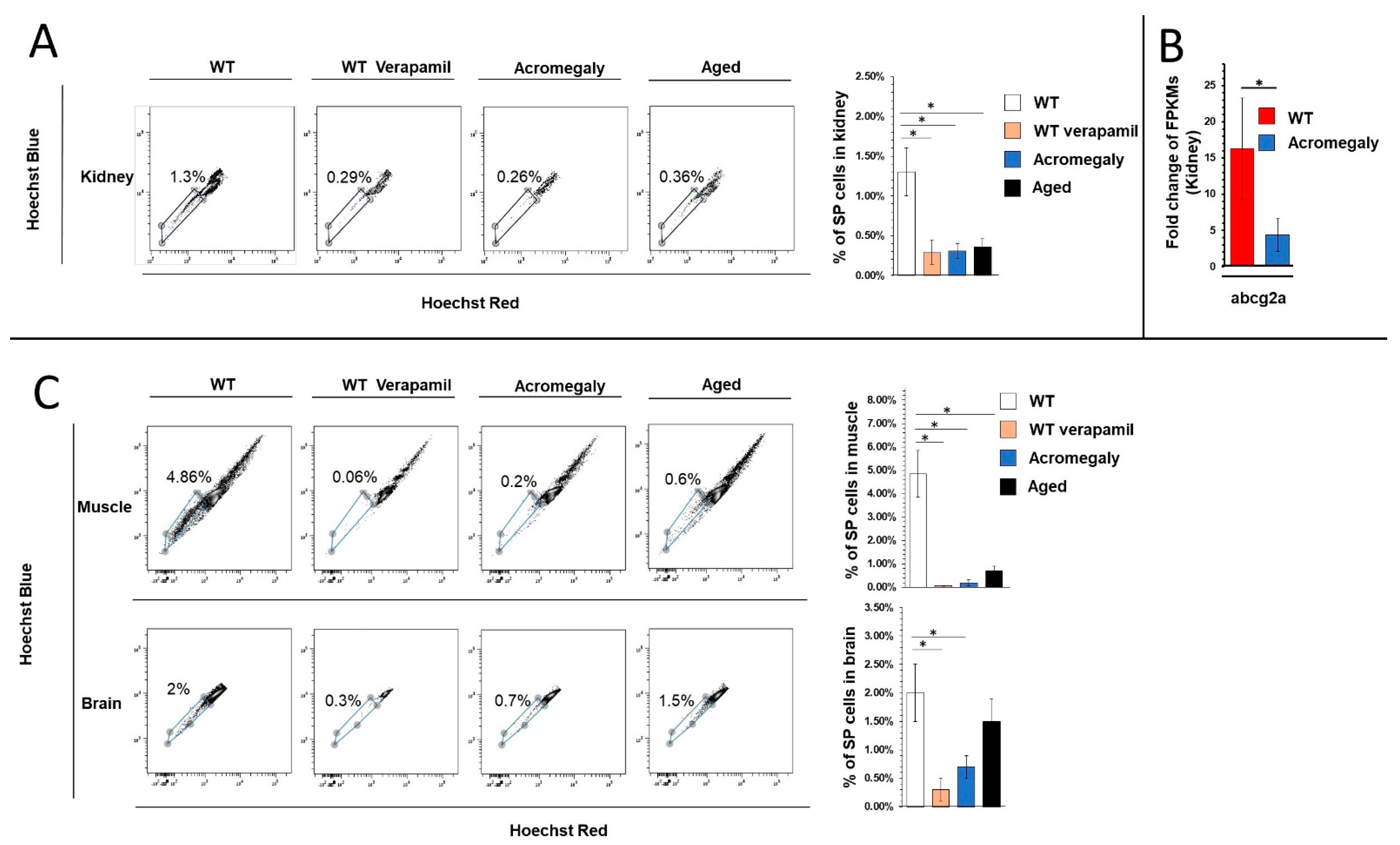
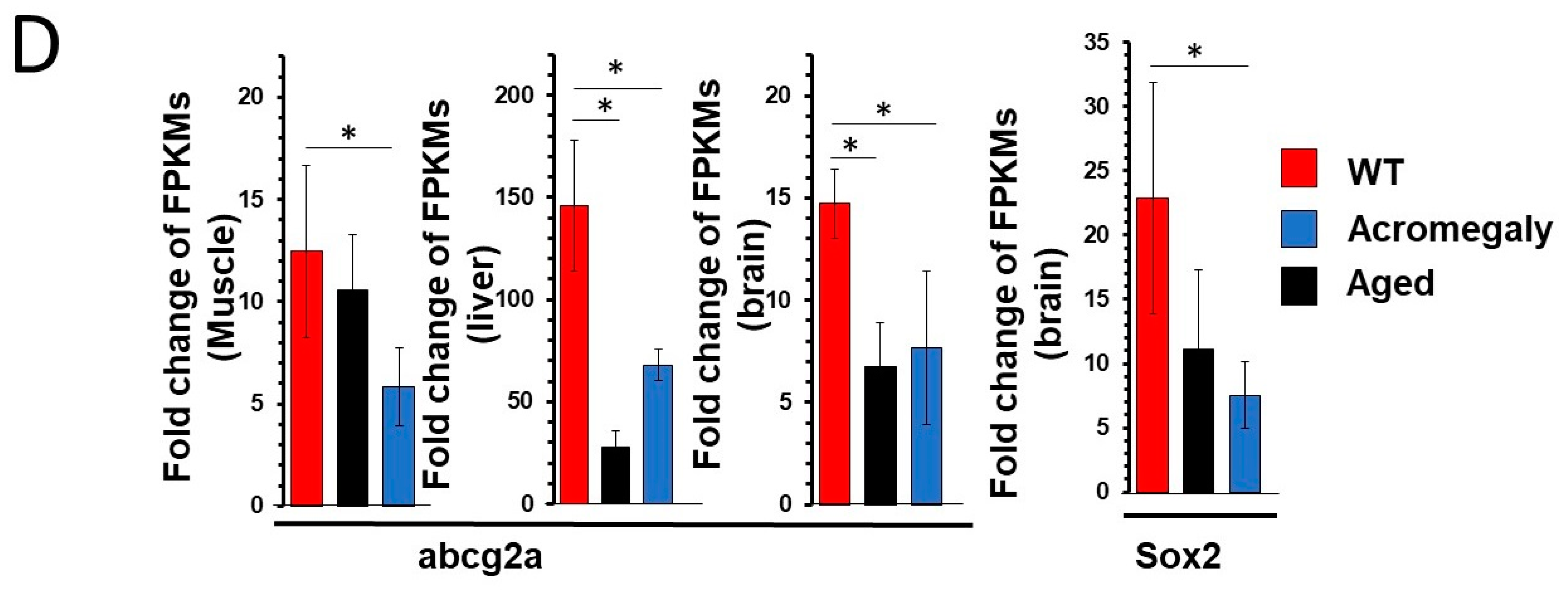
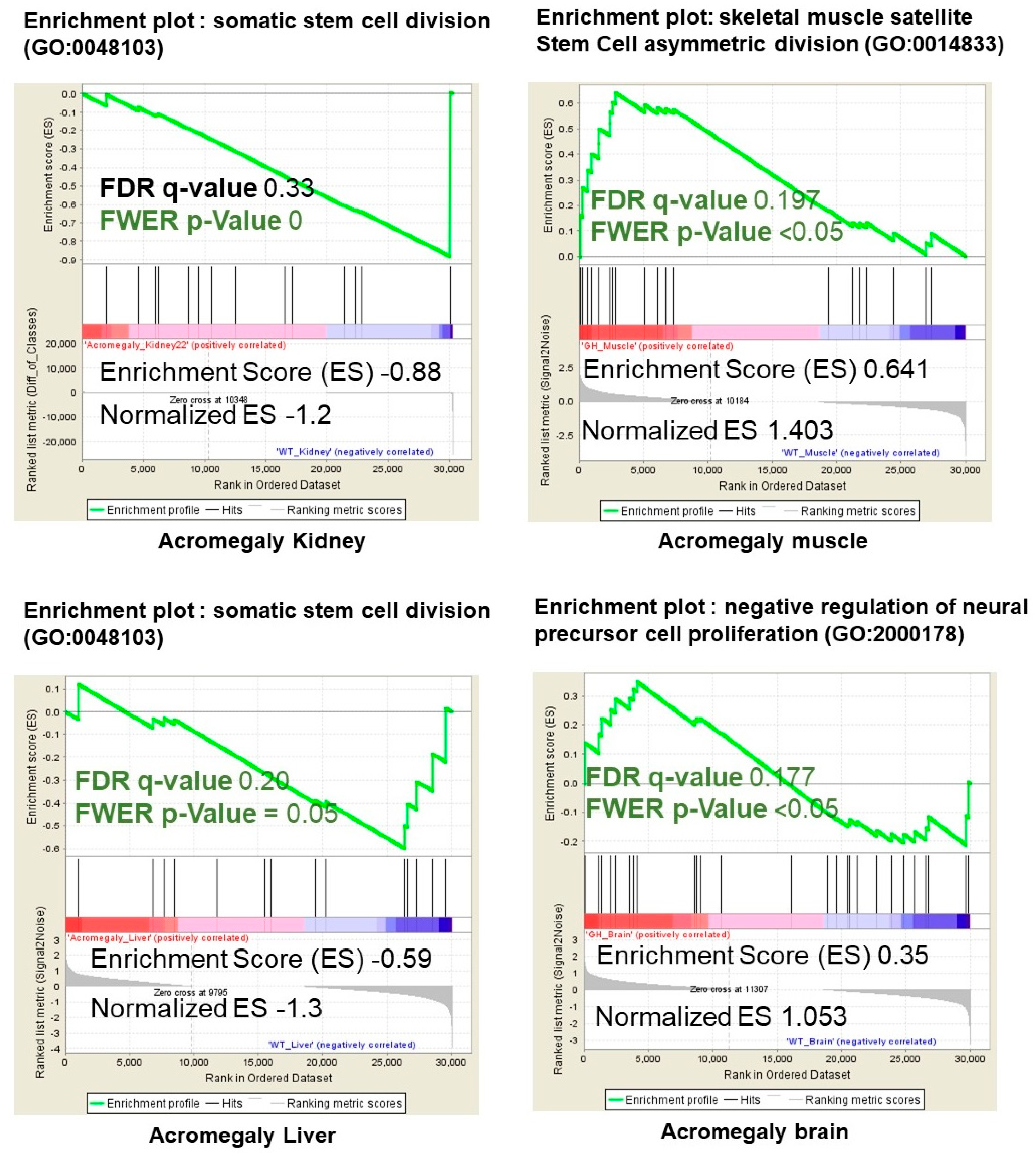
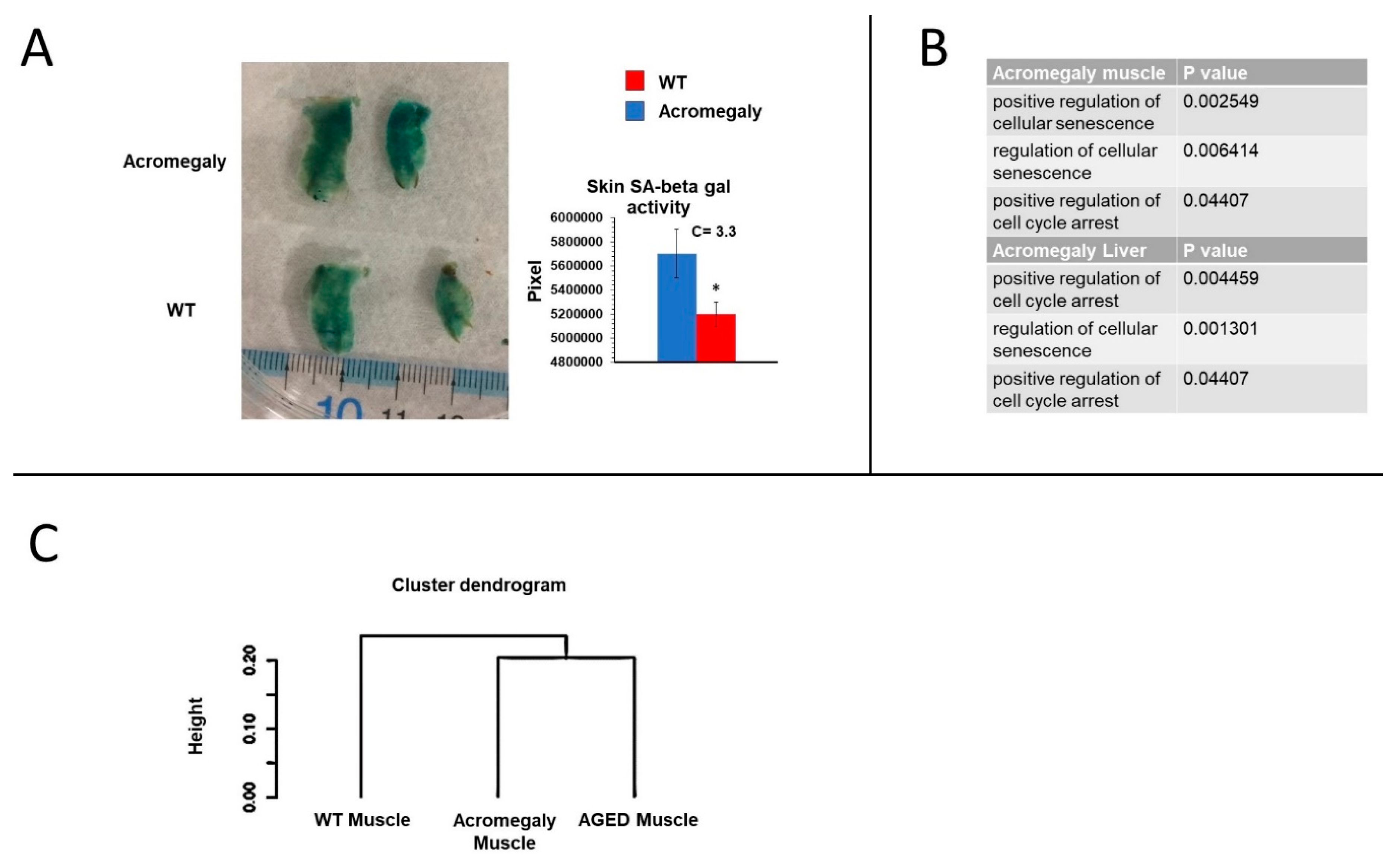
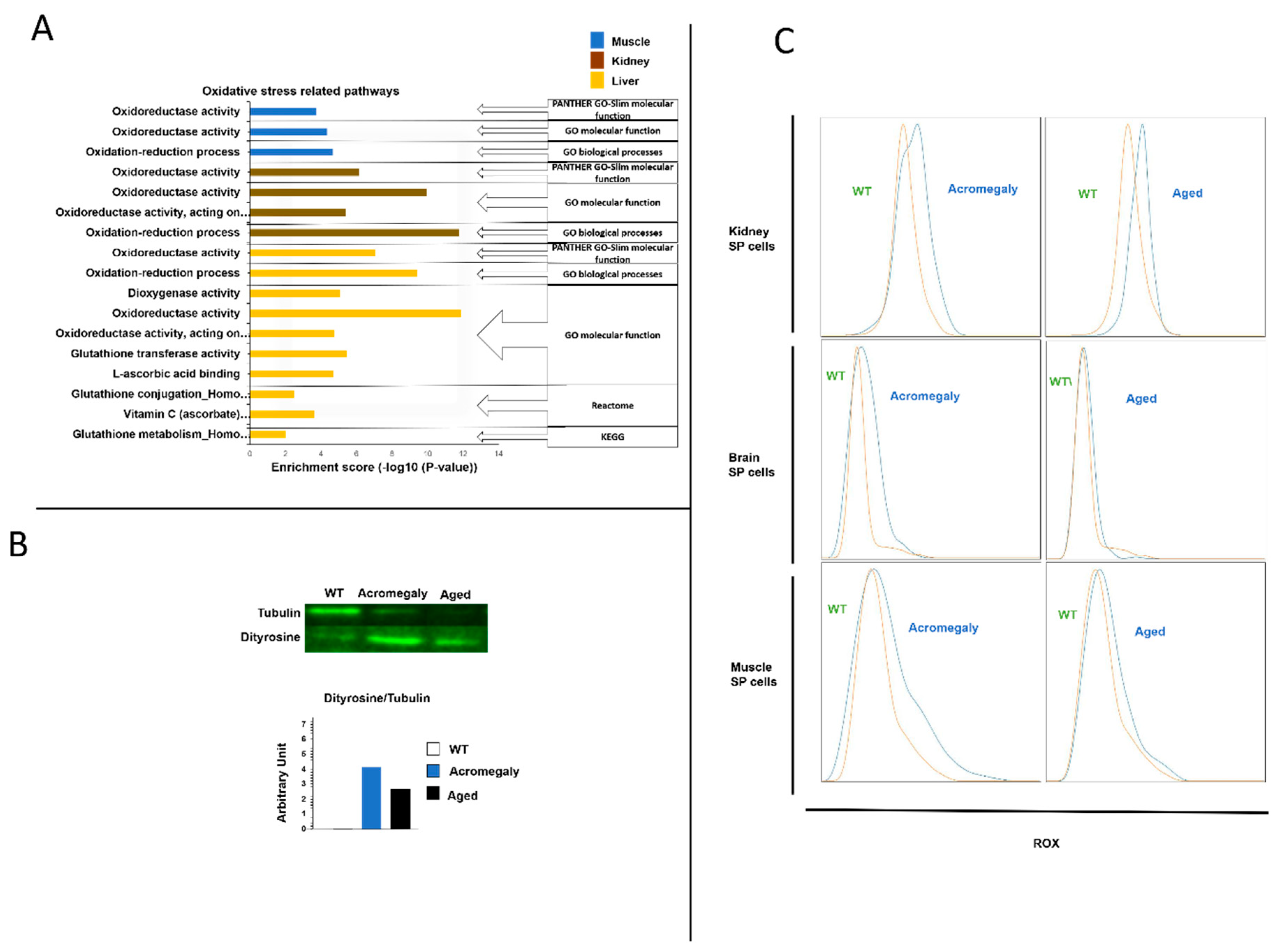
© 2020 by the authors. Licensee MDPI, Basel, Switzerland. This article is an open access article distributed under the terms and conditions of the Creative Commons Attribution (CC BY) license (http://creativecommons.org/licenses/by/4.0/).
Share and Cite
Elbialy, A.; Igarashi, Y.; Asakawa, S.; Watabe, S.; Kinoshita, S. An Acromegaly Disease Zebrafish Model Reveals Decline in Body Stem Cell Number along with Signs of Premature Aging. Biology 2020, 9, 120. https://doi.org/10.3390/biology9060120
Elbialy A, Igarashi Y, Asakawa S, Watabe S, Kinoshita S. An Acromegaly Disease Zebrafish Model Reveals Decline in Body Stem Cell Number along with Signs of Premature Aging. Biology. 2020; 9(6):120. https://doi.org/10.3390/biology9060120
Chicago/Turabian StyleElbialy, Abdalla, Yoji Igarashi, Shuichi Asakawa, Shugo Watabe, and Shigeharu Kinoshita. 2020. "An Acromegaly Disease Zebrafish Model Reveals Decline in Body Stem Cell Number along with Signs of Premature Aging" Biology 9, no. 6: 120. https://doi.org/10.3390/biology9060120
APA StyleElbialy, A., Igarashi, Y., Asakawa, S., Watabe, S., & Kinoshita, S. (2020). An Acromegaly Disease Zebrafish Model Reveals Decline in Body Stem Cell Number along with Signs of Premature Aging. Biology, 9(6), 120. https://doi.org/10.3390/biology9060120




